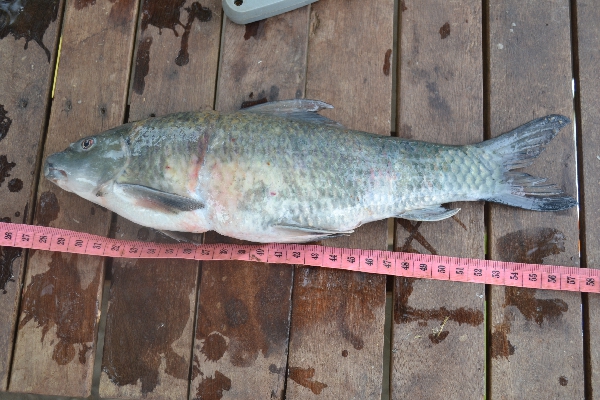Common names:
Unknown
None
Taxonomic tree
Kingdom: Animalia
Phylum: Chordata
Class: Actinopterygii (ray-finned fish)
Order: Cypriniformes (Carps)
Family: Cyprinidae (Carps)
Genus: Labeo
Species: Labeo forskalii (Rüppell, 1835)
Number of Occurrancies: 66
Etymology(based on Sharpf & Lazara 2019)
- Labeo: one with large lips, referring to “remarkably thick, fleshy lips” (translation) of L. fimbriatus and L. niloticus (=vulgaris).
- forskalii: in honor of Swedish explorer and naturalist Peter Forsskål, also known as Petrus Forskål (1732-1763), who had reported this species as a variety of Cyprinus niloticus (=Labeo vulgaris) in a posthumous publication in 1775.
Synonyms: click here to view synonyms
Type locality: Cairo, Nile River, Egypt. Holotype at Senckenberg Museum, Frankfurt (SMF)
General idenfication features for cyprinids: A naked head (=without scales); jaws completely devoid of teeth; one or two pairs of circum-oral barbel, which are, however, absent in some species; no adipose fin; and presence of a sickle-shaped paired pharyngeal bones, each bearing 1-3 series of teeth.
Distinguishing characters for the genus
- -Origin of the dorsal fin well in advance of pelvic fin insertions (vs. Labeobarbus and Enteromius: origin of dorsal fin is above pelvic fin base,or slightly in advance of, or behind this point)
- -Rounded snout with a flap of skin immediately in front of upper lip (vs. Garra: no flap of skin in front of upper lip, but with a well developed, almost circular disc on the chin which confluent with lower lip)
- -Lateral line running along middle of the flank and the caudal peduncle (vs. Rastrineobola, Engraulicypris, and Leptocypris: lateral line is situated below the middle of flank and caudal peduncal, and the cheek below the eye is covered by thin sub-orbital bones)
Distinguishing characters for species
- Eye not visible from below, its diameter 1/4-1/8 head length (relatively larger in smaller fishes) (distinction from L. coubie and L. victorianus)
- Inner surface of lips with transverse folds (distinction from L. horie)
- Depth of body contained 3-4.5 times in standard length, length of head 4-5 times
- Snout rounded, more or less fleshy and swollen, with a distinct curved transverse groove on the upper surface; snout length about half that of the head and somewhat longer than the post-ocular part
- Barbels minute and hidden
- Dorsal fin with III, 9-10 rays, its upper margin concave, and its origin well in advance of pelvic insertions
- Lateral line with 37-42 scales
- Caudal peduncal 1.5-1.25 times longer than deep
- Colour is olive-green above, lighter, almost yellow below; scales of the flanks with pinkish centres
Distribution in Uganda: Lake Edward, Agoye river, West Nile (a tributary of Ala river which flows into the Nile)
Occurence: Native
Habitat: Benthopelagic; in Lake Albert, common in deep water close to rocky shores
Feeding: Detritivore, feeding on mud and plant debris
Biology: The fish can grow up to 48 cm. No information on reproductive biology and life history for Ugandan populations.
Economic importance/End use:Subsistence fishery (food for riparian communities)
IUCN conservation status: click here to view IUCN status
Threats: Fishing
Main references
- Greenwood PH. 1966. The fishes of Uganda. The Uganda Society, Kampala. 131 pages.
- Sharpf C, Lazara J.K. 2019. Fish Name Etymology Database v5. www.etyfish.org

